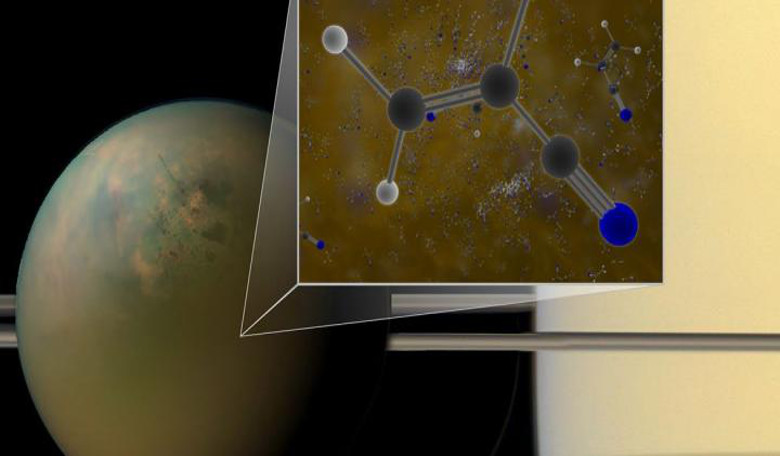A complex chemical compound that might be capable of forming stable, flexible structures similar to cell membranes has been found in sizeable quantities on Saturn's largest moon, Titan.
Nearly as large as Mars, Titan, is one of our solar system's most curious bodies. It shares some similarities with Earth, such as a dense, nitrogen-rich atmosphere – 98.4 percent compared with Earth’s 78 percent – with a smattering of organic, carbon-based molecules, including ethane (C2H6). It also has an equivalent hydrological cycle, but instead of water raining down to create lakes and rivers or freezing as snow, on Titan it is methane.
This toxic environment coupled with its distance from the Sun, has long thought to be a huge barrier to life as we know it to survive and thrive on the Moon’s surface. However it has been suggested that life as we don’t know it could perhaps form, if enough of the right ingredients could be sourced.
Now, using the Atacama Large Millimeter/submillimeter Array (ALMA) a team of scientists have used archival data to find compelling evidence that molecules of a compound known as acrylonitrile (C2H3CN) are present on Titan and in significant quantities.
Also known as vinyl cyanide, on Earth the chemical is used to make plastics, but on Titan researchers have speculated that these molecules could link together to form structures similar to the lipid bilayers of living cells on Earth.
"The presence of vinyl cyanide in an environment with liquid methane suggests the intriguing possibility of chemical processes that are analogous to those important for life on Earth," said Maureen Palmer, a researcher at NASA's Goddard Space Flight Center in Greenbelt, Maryland, and lead author on a paper published in Science Advances.
Lipid bilayers are incredibly thin, flexible membranes that form a continuous barrier around all cells. This barrier acts as a wall, keeping the right stuff in and the wrong stuff out. On a place that is devoid of water, such as Titan, vinyl cyanide could provide the substitute to allow membrane-like structures to form.
"If membrane-like structures could be formed by vinyl cyanide, it would be an important step on the pathway to life on Saturn's moon Titan,” said Michael Mumma, director of the Goddard Center for Astrobiology, which is funded by the NASA Astrobiology Institute.
The team responsible for the discovery say that concentrations of up to 2.8 parts per billion of vinyl cyanide are present in Titan’s atmosphere. Eventually, the Moon’s methane cycle will mean that the vinyl cyanide condenses and is rained out, where it could eventually help fill one of Titan’s great lakes.
If, over the the lifetime of Titan, enough vinyl cyanide accumulated in Ligeia Mare – Titan's second-largest lake – the team calculate that around 10 million extra terrestrial membrane substitutes, or azotosomes to give them their formal name, could be present in every millilitre (a quarter-teaspoon) of liquid. Compared with Earth, that equates to roughly a million bacteria per quarter teaspoon of coastal ocean water.
"The detection of this elusive, astrobiologically relevant chemical is exciting for scientists who are eager to determine if life could develop on icy worlds such as Titan," said Goddard scientist Martin Cordiner, senior author on the paper. "This finding adds an important piece to our understanding of the chemical complexity of the solar system."











